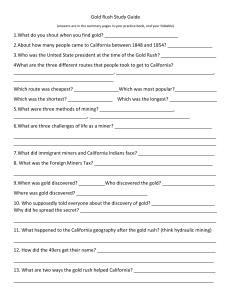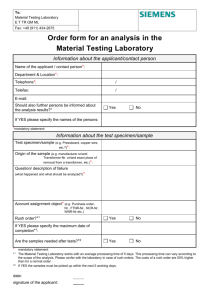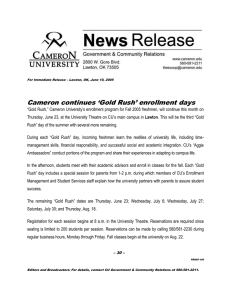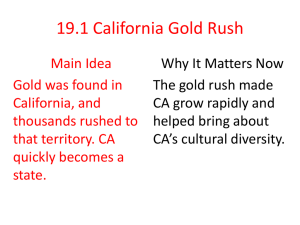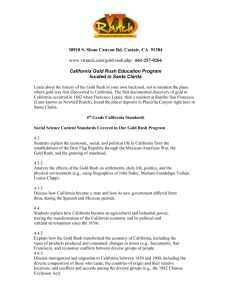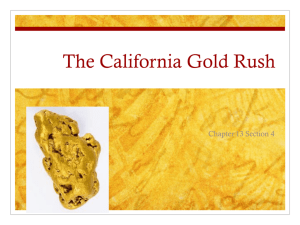Design for Instruction: Unit Plan Social Studies California Gold Rush By: “John Smith”
advertisement
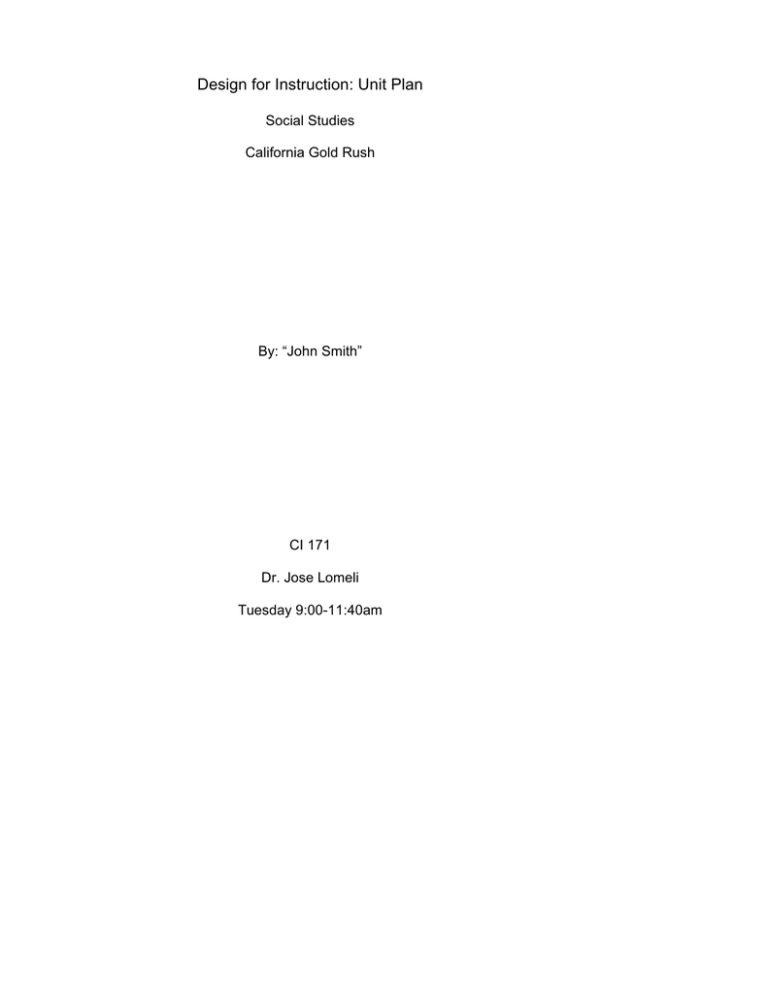
Design for Instruction: Unit Plan Social Studies California Gold Rush By: “John Smith” CI 171 Dr. Jose Lomeli Tuesday 9:00-11:40am Unit Overview The theme as well as the content of this unit is the California Gold Rush. The lessons, goals, and objectives will concentrate on the history and social science content standards for the fourth grade. There will be both writing and speaking activities, however, the focus of the unit will be the history and social science standards. I have found that students tend to retain more information when there are more activities present within a lesson. Because of this, all of the lessons will contain one or more interactive activities to emphasize and reinforce the lessons objectives. This unit will also utilize multiple levels of Bloom’s Taxonomy. The unit addresses several different aspects of the California Gold Rush. The three learning goals along with the related content standards for this unit are as follows: Learning Goal 1: Students will understand, recognize, and explain the importance of the major characters and historical sites involved in the California Gold Rush. History and social science standard 4.3.1 Learning Goal 2: Students will understand the experiences of those who traveled to California during the Gold Rush by land and sea. History and social science standard 4.3.2 Learning Goal 3: Student will research and identify the important women involved in the California Gold Rush. History and social science standard 4.3.4 Unit Plan Outline: 1. Pre-assessment: KWL Chart 2. Lesson 1: Gold Rush Major Players 3. The Virtual California Gold Country 4. Lesson 2: Traveling to the Gold Rush 5. Gold Rush Advertisement / Billboard 6. Lesson 3: Real Ladies 7. Gold Rush Newspaper 8. Post-assessment quiz, complete column ‘L’ of the KWL chart, group discussions This unit includes three lessons, one virtual field trip, one advertisement or billboard, and one newspaper. Lesson #1 focuses on learning goal #1 and ties into history and social science standard 4.3.1. Lesson #2 focuses on learning goal #2 and ties into history and social science standard 4.3.2. Lesson #3 focuses on learning goal #3 and ties into history and social science standard 4.3.4. The activity in each lesson is present in order to further reinforce each goal or objective. The Virtual California Gold Country is an interactive site that allows students a chance to virtually tour the important sites of the California gold rush. It also contains information on the “key players” of the California gold rush. The advertisement or billboard is a fun and hands-on way for the students to demonstrate their knowledge of the different routes and methods of travel used during the gold rush. The newspaper is another way for students to demonstrate their knowledge while still being able to show their creativity. Both the advertisement or billboard and the newspaper are hands-on activities designed to keep students entertained and engaged. The tour is not hands-on but is also designed to keep students entertained and engaged. Technology: Technology will be employed in all three of the lessons and all three of the activities. In the lessons, technology will be utilized primarily via PowerPoint presentations. The information will be presented in this way in order to enhance the class’s interest. Also, this will be used to assist visual learners in retaining the information presented. In the tour, students use technology to navigate their way through the “Gold Country.” In both the advertisement or billboard and the newspaper, technology is used for research and finding information. Resources: Lesson plan ideas and activities were taken from the following sites: 1. Real Ladies http://www.usfca.edu/classes/AuthEd/Glitter%20Gazette/Women.html 2. Virtual California Gold Country http://www.malakoff.com/vcgc.htm 3. Traveling to the Gold Rush http://www.eduplace.com/ss/hmss/4/unit/act3.2.html Assessment Results and Implications The learning goals and objectives for this unit were developed based on a preassessment of the class’s overall knowledge of the California gold rush as well as the History and Social Science Standards for California Public Schools. A KWL chart was used to determine what the students already knew and what they wanted to learn about the California gold rush. Based on the results of the pre-assessment, it is clear that the students know very little correct information about the gold rush. The students only seem to know the very basic aspects of the gold rush. They do not seem to grasp any of the concepts being addressed in any of the learning goals. Since the class did not seem to know anything, I felt that it would be appropriate to address the standards starting with the most basic and low level information. Jose Lomeli 10/20/11 9:06 AM Comment: This section was a bit too general and cursory. You needed to elaborate in a more specific way how you assessed. A chart showing pre, formative and post assessment activities would have been helpful. Also, you didn’t include a learning outcome with individual student scores included. KWL Chart K W L What you Know… What you Want to know… What you Learned… - They found gold in 1849 They found gold at Sutter’s Mill People panned for gold The towns were called “boom towns” The gold rush was in Sacramento - When did they find the gold? Who found the gold? Who are the famous characters? What is the gold rush? Why did they call it the gold rush? Why do they want to pan? What kind of people were there? What does the gold rush look like? Who found the gold? How did the gold rush get here? - Miners used a Long Tom and Cradle to find the gold James Marshall discovered the gold Sam Brennan spread the news of the gold’s discovery Miners wore Levi jeans Levi Strauss invented Levi’s jeans People died on the journey to California 50,000 people died. Some took the Panama Trail Some died of cholera They called the miners 49ers because they came in 1849 There were 3 main routes taken by travelers Abandoned towns were called ghost towns Based upon these two portions of the KWL Chart it is apparent that only a few of the students knew the very basic information surrounding the California gold rush while the vast majority of the students had no idea. Based on what the students want to know, the lessons will need to begin with the most fundamental information about the gold rush. Questions like, What is the gold rush? and Why did they call it the gold rush?, truly show the classes low-level of knowledge. Once the class grasps some of the more basic concepts surrounding the California gold rush, then it will be appropriate to get into more depth with the lessons. Table of Outcomes Unit Outcomes Level of Outcomes Type of Outcome Related Standards (content area, #, and text) Understand, recognize, and explain the importance of the major characters and historical sites involved in the California Gold Rush Level 1: Knowledge Level 2: Comprehension Level 5: Analysis Cognitive, psychomotor, affective History and social science 4.3.1 Identify the locations of Mexican settlements in California and those of other settlements, including Fort Ross and Sutter’s Fort. Understand the experiences of those who traveled to California during the Gold Rush by land and sea Level 1: Knowledge Level 2: Comprehension Cognitive, psychomotor, affective History and social science 4.3.2 Compare how and why people traveled to California and the routes they traveled. Research and identify the important women involved in the California Gold Rush Level 1: Knowledge Level 2: Comprehension Level 6: Evaluation Cognitive, psychomotor, affective History and social science 4.3.4 Study the lives of women who helped build early California. For the Post-assessment, a standard ten question quiz was administered as suggested by the master teacher. For the class as a whole, the average test score was higher than an 82%. This shows me that the students did very well at Jose Lomeli 5/18/09 10:08 AM Comment: This table is appropriate but might be better placed near your overview to give the overall feel of your work at the beginning. retaining the information taught. The master teacher also praised the unit saying that those scores are very high for her typical class average. I was very proud of this fact and was extremely relieved to learn that I was really teaching the class valuable information. I had been worried that they were not going to learn from me and therefore be behind in the future. These test results alleviated my worries. Lesson Plan #1 SUBJECT AREA: Social Studies-Gold Rush TOPIC: Gold Rush Major Characters and Important sites. ACADEMIC CONTENT STANDARD: History and Social Studies 4.3.1 MATERIALS: Computers, PowerPoint on Gold Rush players 1) OBJECTIVES a) LEARNING OUTCOME/GOAL: Students will understand, recognize, and explain the importance of the major characters and historical sites involved in the California Gold Rush. b) OBJECTIVE: After discussion of the important players during the gold rush, students will get into groups and virtually explore the California Gold Country. During their exploration, students should take notes on three important players of their choosing. At the end, they will join two other groups and share their notes with each other. Each group will learn about multiple characters this way. 2) ANTICIPATORY SET: I will start by having the students close their eyes and visualize themselves living during the California gold rush. Would they want to be a miner, a merchant, or maybe the captain of a ship taking people to California? Then, I will tell them that today we will be discussing the important characters of the California gold rush. We will learn about each specific person’s importance or contribution to the gold rush. 3) TEACHING/PRESENTATION a) INPUT: I will describe some of the key players of the California gold rush while showing a few pictures of them on a PowerPoint. I will model the reasons for these people’s importance while discussing and exploring them with the class b) MODELING: i) I’ll do it – Listen as I describe a few of the important characters of the California gold rush era. ii) You help me – Help me to describe a few of the important characters of the California gold rush era. iii) I’ll help you – Now, you find out some of the important people from the California gold rush era and I will help you (if needed). iv) You do it – Now, you describe three of the important people from the California gold rush era and share them with your group. c) CHECKING FOR UNDERSTANDING: Throughout the lesson, I will ask prompting questions to make certain students understand the different people being discussed. I will also ask individuals students for responses during the discussion and activity. While the students explore the Virtual California Gold Country, I will walk around and check to make sure the information is correct on each person. As the groups discuss the different people they researched, I will walk around and make sure all students understand and are participating. At the end, I will collect the student’s notes and review them to be certain that all of the students were successful in learning about three key characters. 4) STRUCTURED PRACTICE: Now we are going to go over a few important people during the California gold rush. While we do this, think about which three people you would like to learn more about. 5) GUIDED PRACTICE: Now you will work with a partner to research and briefly study three important people during the California gold rush. Then, join with two other sets of partners and share your answers with each other. 6) CLOSURE: Now, as a class, let’s share some of the main points about each of the important people from the California gold rush era. 7) INDEPENDENT PRACTICE: Go home and further explore the Virtual California Gold Country on your own. Come back to class with any questions you may have thought of. 8) ASSESSMENT PLAN: My assessment plan will be to use an oral review throughout the lesson. I will ask questions and listen to the student’s responses to gauge their understanding. I will also walk around to each pair of students to be sure all of their information is correct. If there is incorrect information, I will help that group individually until they fully understand. Lesson Plan #2 SUBJECT AREA: Social Studies-Gold Rush TOPIC: Traveling to the Gold Rush ACADEMIC CONTENT STANDARD: History and Social Science 4.3.2 MATERIALS: To the Gold Rush! Worksheet, Gold Rush routes PowerPoint, plain white paper, markers/crayons, etc. 1) OBJECTIVES a) LEARNING OUTCOME/GOAL: Students will understand the experiences of those who traveled to California during the Gold Rush by land and sea. b) OBJECTIVE: After discussion of the different routes available at the time, students will choose one route and create an advertisement that demonstrates their knowledge of one of the routes. This advertisement should contain the route name, length of time, the cost, food available, weather, pros and cons, and other important details of that route. 2) ANTICIPATORY SET: We have been discussing the Gold Rush. We have learned about the people, culture, and food of the Gold Rush. Today we are going to learn about the different routes that were taken to California. We will learn about the positives and negatives or pros and cons of each route taken. 3) TEACHING/PRESENTATION a) INPUT: I will describe the aspects of each route while showing a few brief pictures on a PowerPoint. I will model the different aspects of each route while discussing them with the class. b) MODELING: i) I’ll do it – Listen as I discuss the different aspects of each route. ii) You help me – Help me identify the different aspects of each route. v) I’ll help you – Now identify the different aspects of each route and I will help you if needed. vi) You do it – Now you identify the different aspects of each route for me. c) CHECKING FOR UNDERSTANDING: I will ask prompting questions throughout the lesson to make certain students understand the different aspects discussed. I will also ask individuals for responses during the discussion and activity. While the students make their advertisement I will walk around and check to make sure the information is correct on each one. 4) STRUCTURED PRACTICE: Now we are going to go over the different aspects of each route. While we do this, check your worksheet to make sure all of the information is correct. 5) GUIDED PRACTICE: Now you will work with a partner to create an advertisement for one of the routes. Make sure to include all of the information from the worksheet in your advertisement. 6) CLOSURE: Okay, now let’s compare and contrast the different aspects of each route as a class. If you were traveling to California which route would you choose? 7) INDEPENDENT PRACTICE: Please complete this advertisement at home if you did not finish it during class time. 8) ASSESSMENT PLAN: My assessment plan will be to use an oral review throughout the lesson. I will also check each advertisement to be sure all of the information is correct. If there is incorrect information, I will help that student individually. Lesson Plan #3 SUBJECT AREA: Social Studies-Gold Rush TOPIC: The Role and Importance of Women during the California Gold Rush ACADEMIC CONTENT STANDARD: History and Social Science 4.3.4 MATERIALS: computer, blank paper, research materials 1) OBJECTIVES a) LEARNING OUTCOME/GOAL: Students will research and identify the important women involved in the California Gold Rush b) OBJECTIVE: After discussion and exploration, students will research and identify the important women of the California gold rush. The students will then be broken into groups of three to four. As pioneering journalists your group will design and create your own newspaper which illustrates their expertise on the important women of the California gold rush. Each group member should write at least one article and draw one picture for the paper. The newspaper should also contain: a. Title b. Date/place/cost c. Lead story d. Supporting articles e. Interesting pictures f. Table of Contents g. Weather h. Obituaries i. Advertisements 2) ANTICIPATORY SET: I will indicate the goals and objectives the lesson, students will research and identify the important women involved in the California Gold Rush. I will show them a PowerPoint displaying various pictures of women during the gold rush to motivate interest in the lesson. 3) TEACHING/PRESENTATION a) INPUT: I will briefly describe the various roles of women during the California gold rush. While describing these roles, I will show a PowerPoint that displays portraits of women and their possible roles during the gold rush. b) MODELING: i) I’ll do it – Listen as I describe and explain the different roles of women during the gold rush. ii) You help me – Help me describe the different roles of women during the gold rush. iii) I’ll help you – Describe to me the different roles of women during the gold rush and I will help you (if needed). iv) You do it – Now, describe for me the roles of women during the gold rush on your own. c) CHECKING FOR UNDERSTANDING: I will ask prompting questions throughout the lesson to make certain students understand the different aspects discussed. I will also ask individuals for responses during the discussion and activity. While the students make their newspaper I will walk around and check to make sure the information is correct on each one. I will also help the students with any other questions while they research. 4) STRUCTURED PRACTICE: Now we will go over the important women and roles available to women during the California gold rush. 5) GUIDED PRACTICE: Now you will work individually and in your group to create the newspaper. Make sure all the information and requirements are included in your final project. 6) CLOSURE: As a class let’s discuss some of the different jobs and roles of women during the gold rush era. 7) INDEPENDENT PRACTICE: The students will work on their articles and assignments at home as part of their homework for the week. 8) ASSESSMENT PLAN: My assessment plan will be to use an oral review throughout the lesson. I will also check each newspaper to be sure all of the information is correct. If there is incorrect information, I will help those students on an individual basis. Lesson taken from: http://www.usfca.edu/classes/AuthEd/Glitter%20Gazette/Women.html#Create Appendix Gold Rush Quiz Name: _______________ Date: _________________ Circle the CORRECT answer. 1. Which of these was NOT a route taken to California? a) b) c) d) 2. Who was the first person to find gold? a) b) c) d) 3. 1846 1847 1848 1849 What is the MOST important thing about John Sutter? a) b) c) d) 5. John Sutter James Marshall Sam Brennan Levi Strauss In what year was gold found? a) b) c) d) 4. The Oregon Trail The Panama Route The Mojave Pass Around Cape Horn He went broke because of the Gold Rush. He spread the news of gold’s discovery. Gold was discovered at his mill. He started Levi’s jeans. Which of these was NOT a tool used to find gold? a) b) c) d) Pan Long Tom Hydraulic Hose Crib 6. What is the name of the person who started Levi’s Jeans? a) b) c) d) 7. Who owned Sutter’s Fort? a) b) c) d) 8. Levi Strauss Jim Jones John Ruiz Alexander Perez Sam Brennan James Marshall John Sutter Levi Strauss Which was the first method used to find gold? a) b) c) d) Stamp Mill Dredger Panning The Cradle TRUE or FALSE ______ 9. Sutter’s Fort is near Sacramento. ______ 10. Most people who came to California in search of gold were successful. Name: Date: To the Gold Rush! As you read about travel to California during the Gold Rush, keep track of the following: The route (overland, around South America, across Panama): Length of time: The cost: Food available: The weather: Possible delays; problems or hardships: Advantages/disadvantages of the route: Any other interesting or important details: Design for Instruction (Rubric) Rating Indicator Alignment with Learning Goals and California Content Standards Accurate Representation of Content Lesson and Unit Structure and Overall Professionalism 1 Indicator Not Met 4 Indicator Partially Met 8 Indicator Met Few lessons are explicitly linked to learning goals. Few learning activities, assignments and resources are aligned with learning goals. Not all learning goals are covered in the design. No reference to content standards Teacher’s use of content appears to contain numerous inaccuracies. Content seems to be viewed more as isolated skills and facts rather than as part of a large conceptual structure. The lessons within the unit are not written appropriately, logically organized (e.g., sequenced). The quality of the unit overall is inferior. Most lessons are explicitly linked to learning goals. Most learning activities assignments and resources are aligned with learning goals. Most learning goals are covered in the design. Some reference to content standards Teacher’s use of content appears to be mostly accurate. Shows some awareness of the big ideas or structure of the discipline. All lessons are explicitly linked to learning goals. All learning activities, assignments and resources are aligned with learning goals. All learning goals are covered in the design. Content standards are articulated appropriately. Teacher’s use of content appears to be accurate. Focus of the content is congruent with the big ideas or structure of the discipline. The lessons within the unit are adequately written, have some logical organization and appear to be somewhat useful in moving students toward achieving the learning goals. The quality of the unit overall is adequate. Some variety in instruction, activities, assignments, or resources but with limited contribution to learning. Very little evidence of higher level thinking skills. All lessons within the unit are appropriately written, logically organized and appear to be useful in moving toward achieving the learning goals. Professional quality unit evidenced by correct grammar, spelling, etc. Significant variety across instruction, activities, assignments, and/or resources. Utilize at least two different models of teaching. Evidence of higher level thinking skill development. This variety makes a clear contribution to learning. Most instruction has been designed with reference to students and their context and pre and post assessment data. Most activities and assignments appear productive and appropriate for each student. Use of a Variety of Instructional Models, Activities, Assignments & Resources Minimal variety of instruction, activities, assignments, and resources. Heavy reliance on textbook or single resource (e.g., worksheets). No evidence of higher level thinking skills. Use of Contextual Information and Data to Select Appropriate and Relevant Activities, Assignments & Resources Total: Instruction has not been designed with reference to students and their context and pre-assessment data. Activities and assignments do not appear productive and appropriate for each student. Some instruction has been designed with reference to students and their context and pre-assessment data. Some activities and assignments appear productive and appropriate for each student. Overall there were some strengths in your unit. I thought your lesson plans were well written though they could have used more depth. There were some areas that could be improved such as a more detailed and conceptualized assessment plan. It was too general to give a clear picture of what students knew and didn’t know and how to address student needs. I also noticed there was no rationale included for the lesson plans. Score 7 7 6 6 5 31
